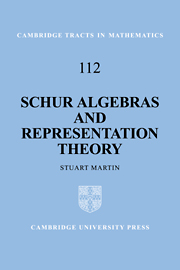Book contents
- Front matter
- Contents
- Introduction
- 1 Polynomial functions and combinatorics
- 2 The Schur algebra
- 3 Representation theory of the Schur algebra
- 4 Schur functors and the symmetric group
- 5 Block theory
- 6 The q-Schur algebra
- 7 Representation theory of Sq(n, r)
- Appendix: a review of algebraic groups
- References
- Index of Notation
- Index of Terms
1 - Polynomial functions and combinatorics
Published online by Cambridge University Press: 22 September 2009
- Front matter
- Contents
- Introduction
- 1 Polynomial functions and combinatorics
- 2 The Schur algebra
- 3 Representation theory of the Schur algebra
- 4 Schur functors and the symmetric group
- 5 Block theory
- 6 The q-Schur algebra
- 7 Representation theory of Sq(n, r)
- Appendix: a review of algebraic groups
- References
- Index of Notation
- Index of Terms
Summary
Introductory remarks
This chapter opens with a brief summary of Schur's work on the complex polynomial representations of the general linear group GLn(C) of n × n nonsingular matrices with entries in C; we then proceed to analyse ways of extending his ideas to representations over an infinite field K of arbitrary characteristic. Thus, Schur considered a polynomial matrix representation of M ∊ GLn>(C), i.e. a group homomorphism T : GLn(C) → GLm(C) such that each entry of T(M) could be expressed as a polynomial with complex coefficients in the entries of M; however we shall study a KGLn(K)-module V whose coefficient space lies in the bialgebra AK(n) generated by the n2 coordinate functions. In this way V affords a matrix representation whose entries are polynomials over K in the original entries. We shall then take the rth homogeneous component, AK(n, r), of AK(n) and consider the category of all representations having coefficient space lying in this component. Basic properties of the coalgebra AK(n, r) are catalogued in 1.3.
Throughout the text the methods employed use a blend of the standard combinatorial machinery. Nowadays I can safely assume that the combinatorics of partitions and their associated Young diagrams is well known, so no more than a cursory treatment is given in 1.4. This leads to one definition of a weight (as a certain n-tuple of integers) and we connect this idea with the algebraic group concept of weight (arising from the action of the torus) in 1.5.
Information
- Type
- Chapter
- Information
- Schur Algebras and Representation Theory , pp. 1 - 24Publisher: Cambridge University PressPrint publication year: 1994
